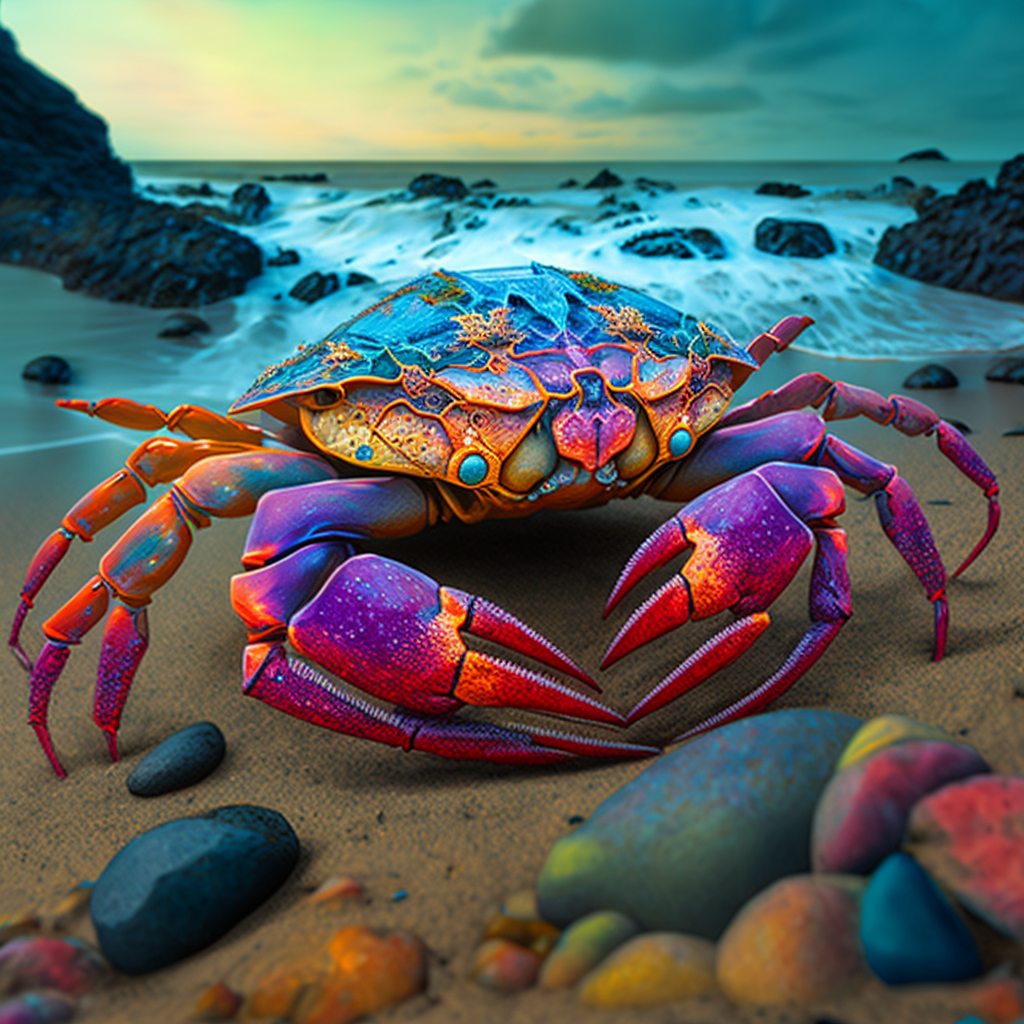Glistening Crab
I’m telling you I can wait to get these crabs to shore, where going to make a fortune. - FishermenThe Glistening Crab is a colorful species of carb known to live on beaches across the Isles of Refuge. These crabs mainly live under the land and near coral reefs, allowing them to blend in with them due to their multi-colored shells. They are considered a delicacy and are often hunted for their meat.
Basic Information
Anatomy
A crustation with six legs and a set of claws attach to a round body. The entire body is covered with a hard shell to protect it from harm.
Biological Traits
Camouflage : These Creatures can conceal themselves in their environment due to the color of their bodies. Allowing them to better hunt or protect themselves from predators without any other creature noticing them unless with their sight.
Hard Body: Their bodies are much stronger than most other creatures making it very difficult to get through their skin and other defenses. Often taking a strong force or something very sharp can break through it.
Genetics and Reproduction
Glistening Crabs reproduce with a male and a female by laying eggs. These eggs are laid in salt water, often in a crevasse or an area of rocks, and take about two weeks to hatch them having no exoskeleton take a few days to come in, and have a brown color to them.
Growth Rate & Stages
It takes about five months for a crab to be fully grown, with them molting their shells several times as they grow to become larger, with them becoming more colorful every time they molt.
Ecology and Habitats
Glistening Crabs live in tropical climates, on beaches, and the water near them, often in reefs. They often live in groups, remain hidden as much as possible during the day, and go hunting at night. When on land, they will burrow into the sand on a beach to hide from predators and come out when needed.
Dietary Needs and Habits
Glistening Crabs are carnivores that hunt small fish, small lizards, Shrimp, and sea slugs by using their claws to grab and eat them while they are still alive. They have also been known to eat corpses that are near them.
Biological Cycle
Glistening Crabs are naturally nocturnal, often hunting at night to avoid predators and hunting prey at night.
Behaviour
Glistening Crabs are territorial creatures often found in groups but have no social ties with one another, often sticking to have a better chance to find food and avoid predators. Anything they catch in their claws is considered food, and they will often use their claws to fight off anything larger than them as they are seen as a threat.
Additional Information
Social Structure
Glistening Crabs only tolerate each other, often staying a certain distance from each other to hunt ad only come to go into another space to fight for food or mates.
Uses, Products & Exploitation
Glistening Crabs are desired for their meat which is considered a delicacy, and their colorful shells are used as decorations.
Geographic Origin and Distribution
Glistening Crabs surround the Isles of Refuge across many islands and waters.
Average Intelligence
Glistening Crabs can remember complex things such are travel routes and even know when they are in danger or not.
Perception and Sensory Capabilities
Sight: Great
Sound: Decent
Smell: Great
Scientific Name
Class: Natural
Lifespan
7 - 18 years
Average Height
8 - 14 inches
Average Weight
2 - 4 pounds
Average Length
7 - 9 inches
Body Tint, Colouring and Marking
Blue, yellow, red, green, orange, purple
Geographic Distribution
Favored Food
I do have to say that this crab meat is divine; the taste alone makes me want to have another one of these as soon as I can - First Time EaterGlistening Crabs are a very popular food in the Isles of Refuge and other regions of the world due to their tastes and texture being a mix of sweet and spicy flavors in soft meat. Making it common for fishermen to find them as much as possible to sell them for a reasonable price on them. There are even those who are experts at finding these crabs by diving into the dangerous water of the isles to catch them just by looking at reefs to see if they are there.
Masters of Hiding
You have a keen eye for finding these crabs in their dwellings. Their color matches the same colors of the coral, making it all that harder to find. - Crab FishermenDue to their being on the menu of most predators in the food chain, Glistening Crabs have adapted to blend into the colorful coral reefs surrounding the isles to hide from them better in the day and come out at night to move. Making it all the more difficult to find them in the water and even on land if they burrow themselves in the sand on a beach as they go deep underground to avoid their color scheme being seen by anything.




Comments